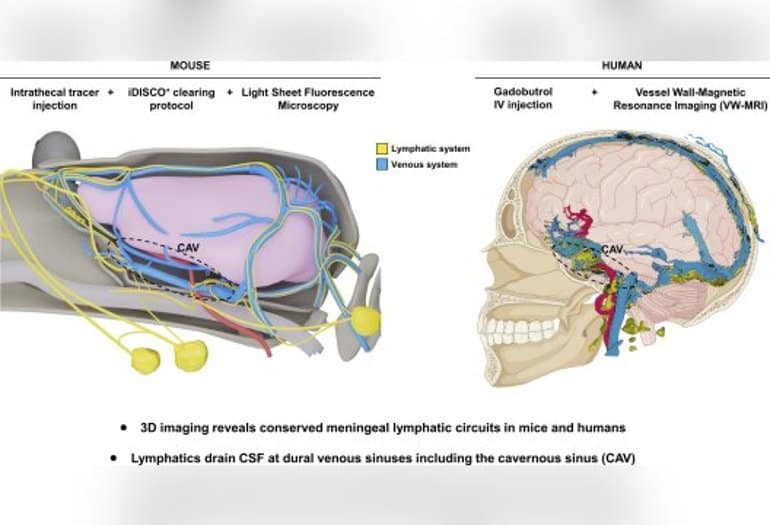Summary: The CSF drainage pathways are similar between mice and humans, researchers discovered.
Source: Yale
Meningeal lymphatic vessels are potential targets to treat brain diseases. Laboratories at Yale and the Paris Brain Institute (Pitié-Salpêtrière Hospital, Paris) have imaged brain drainage by meningeal lymphatics in mice and in humans.
The recent Journal of Experimental Medicine paper led by Jean-Leon Thomas, Ph.D., professor of neurology, and Anne Eichmann, Ph.D., Ensign Professor of Medicine and professor of cellular and molecular physiology and co-director of Yale’s Cardiovascular Research Center (YCVRC), demonstrates that CSF drainage pathways are similar between mice and humans and reports a novel MRI-based imaging technique for patients with neurological diseases.
The lymphatic vascular system controls immune surveillance and waste elimination within tissues and organs. Lymphatic vessels are absent from the central nervous system (CNS) but present at the CNS borders, in the meninges that protect the brain and the spinal cord. The meningeal lymphatic vessels are draining into the lymph nodes of the neck and the peripheral immune system, which makes them key players in brain immunity control.
The meningeal lymphatic vessels are also important for waste removal from the brain, by participating in the clearance of interstitial fluid and soluble proteins, as well as in the drainage of CSF that provides the brain with a protective fluid buffer against injury, a pathway for essential nutrients, and disposal system for cellular waste.
The meningeal lymphatic system affects neurological diseases in many mouse models, including Alzheimer’s disease, multiple sclerosis, brain tumors and other conditions. “Because of its involvement in many diseases, the meningeal lymphatic system has attracted a lot of therapeutic interest” explains Laurent Jacob, Ph.D., first author of the study and a member of the Paris research team.
“However, it remained unclear where the lymphatic recapture of CSF molecules occurs in the context of the whole head, in mice or in humans.”
To learn more about the architecture and function of the meningeal lymphatic network, the team investigated CSF lymphatic drainage using postmortem light-sheet imaging in mice and real-time magnetic resonance imaging in humans. By combining these approaches, the authors rebuilt the entire lymphatic drainage network of the CSF.
The 3D imaging showed that the meningeal lymphatics contact the venous sinuses of the dura mater, and revealed an extensive meningeal lymphatic network around the cavernous sinus in the anterior part of the skull. From there, meningeal lymphatics exit the skull through cranial foramina and drain into cervical lymph nodes.

Stéphanie Lenck, MD, also at the Pitié-Salpêtrière Hospital, performed quantitative lymphatic MRI in 11 patients affected by various neurological diseases. She established a procedure for 3D-visualization of all blood and lymphatic vasculature in the meninges and the neck that revealed a significantly greater meningeal lymphatic volume in men than in women.
Future research will have to explore whether this anatomical data is causally related to the greater predisposition of women to develop neurological diseases such as multiple sclerosis, meningiomas or intracranial hypertension.
“Meningeal lymphatic vessels are potential targets to treat brain diseases,” said Eichmann. “Laboratories at Yale are making progress toward elucidating their function by imaging brain drainage by meningeal lymphatics in mice and in humans.”
About this neuroscience research news
Author: Elisabeth Reitman
Source: Yale
Contact: Elisabeth Reitman – Yale
Image: The image is credited to the researchers
Original Research: Open access.
“Conserved meningeal lymphatic drainage circuits in mice and humans” by Laurent Jacob et al. Journal of Experimental Medicine
Abstract
Conserved meningeal lymphatic drainage circuits in mice and humans
Meningeal lymphatic vessels (MLVs) were identified in the dorsal and caudobasal regions of the dura mater, where they ensure waste product elimination and immune surveillance of brain tissues. Whether MLVs exist in the anterior part of the murine and human skull and how they connect with the glymphatic system and extracranial lymphatics remained unclear.
Here, we used light-sheet fluorescence microscopy (LSFM) imaging of mouse whole-head preparations after OVA-A555 tracer injection into the cerebrospinal fluid (CSF) and performed real-time vessel-wall (VW) magnetic resonance imaging (VW-MRI) after systemic injection of gadobutrol in patients with neurological pathologies.
We observed a conserved three-dimensional anatomy of MLVs in mice and humans that aligned with dural venous sinuses but not with nasal CSF outflow, and we discovered an extended anterior MLV network around the cavernous sinus, with exit routes through the foramina of emissary veins. VW-MRI may provide a diagnostic tool for patients with CSF drainage defects and neurological diseases.






